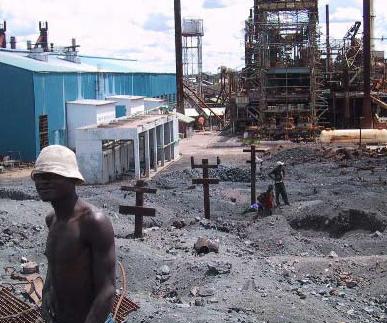 In sommige wijken van Kabwe is de omgeving zo vervuild dat kinderen niet meer buiten kunnen spelen. Er is weliswaar een goede start gemaakt om het effect van 90 jaar zink- en lood- verontreiniging op te lossen, maar Kabwe is nog steeds smerig. Terwijl de fondsen om dit te verbeteren uit het Copperbelt Environmental Project (CEP) op dreigen te raken. Kabwe luidt de noodklok!
In sommige wijken van Kabwe is de omgeving zo vervuild dat kinderen niet meer buiten kunnen spelen. Er is weliswaar een goede start gemaakt om het effect van 90 jaar zink- en lood- verontreiniging op te lossen, maar Kabwe is nog steeds smerig. Terwijl de fondsen om dit te verbeteren uit het Copperbelt Environmental Project (CEP) op dreigen te raken. Kabwe luidt de noodklok!
Bron: Zambia Daily
In certain areas of Kabwe the dust is so contaminated with lead that children should not play in it. Although lots have been done to minimise the impact of 90 years of zinc and lead mining, Kabwe is still not clean. And now the funding to the Copperbelt Environmental Project (CEF) is about to dry up (Daily Mail 30).
In its heyday, Kabwe boasted one of largest and richest lead mines in Africa. Mining and smelting ran almost continuously up until 1994 without addressing the dangers of pollution with lead – one of the most potent neurotoxins. Today, Kabwe is among the top ten most polluted cities in the world, according to the Blacksmith Institute. The CEP, funded by the World Bank and the Nordic Development Fund and managed by the Zambia Consolidated Copper Mines Investment Holdings (ZCCM-IH), has been seeking to address the effects of lead poisoning in Kabwe. Residents with high blood levels have been treated and the environment has been cleaned up near the closed mine. CEP has also established environmental public information centres, water infrastructure and play parks in 11 communities worst affected. Lead is particularly harmful to infants and children. According to the World Health Organisation, blood levels above 10 microgrammes per decilitre (μg/dl) are considered unhealthy. Above 40 μg/dl, symptoms of acute lead poisoning become apparent, including nausea, vomiting and diarrhea. Levels exceeding 120 μg/dl can cause permanent brain damage and death. Children who play in the dust and young men who scavenge the mine for scraps of metal are most susceptible to lead poisoning through inhalation. The United States’ regulatory levels for lead concentrations in soil are 2,000 ppm for industrial sites and 400 ppm for residential sites. Soil samples collected in 1995 from residential yards and surrounding areas in Kabwe showed lead levels higher than 4,000 ppm. In samples near the mine’s waste water canal, which ran through the heart of several housing districts, the lead levels exceeded 250,000 ppm.
According to the ZCCM-IH, children who are currently under observation and treatment for lead poisoning in Kabwe display an average concentration of 60 μg/dl. The target of 25 μg/dl has not yet been achieved, emphasised CEP medical doctor, Virginia Walubita. Regardless, the funding to the CEP is scheduled to stop in March 2011, which probably will result in the dissolution of the CEP. Likely stakeholders to get involved in the clean-up in Kabwe include the Kabwe Municipal Council and the ministries of Health and Community Development and Social Services. Hopefully this will happen - especially considering that investors,
according to ZCCM-IH, have expressed interest in mining lead in Kabwe once again.
